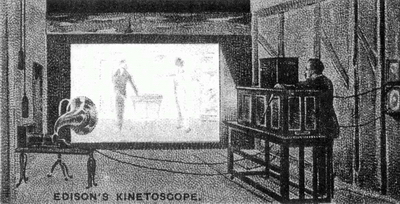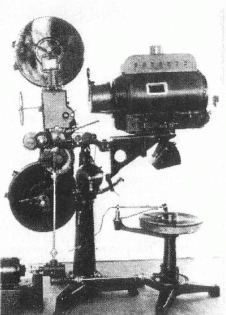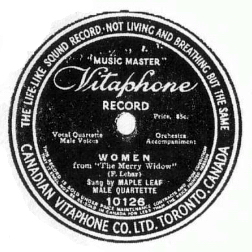|
The Vitaphone Project
by Barry R. Ashpole
The Vitaphone Project is an ambitious
undertaking by a group of U.S.
collectors to recover and restore — and hopefully see re-issued — what remains of a priceless legacy
from the earliest days of the film and sound recording
industries. The project takes its name from the Warner Bros.
Vitaphone studios which produced by far the greatest
variety of "film shorts". Following is a condensed version
of the authors presentation to the CAPS meeting April 2nd.
Edison's Kinetoscope

|
|
The first "talking pictures" to be a viable, commercial proposition in North America comprised of two distinctly separate elements: the
image on a single reel of celluloid film, and the sound
on a 12-inch or 16-inch shellac disc. Of the many thousands of these "filmshorts" produced during a ten-year
period beginning in 1926, only a handful survive complete. Lost or destroyed are one or both elements.
Gone are countless memorable performances by artists
of the day, some of whom made no other form of
commercial recording.
Poor quality sound and imperfect synchronization
plagued the first attempts at "talking pictures".
In 1889, Thomas Alva Edison introduced the
Kinetophone. Edison produced a series
of films with
sound, using a large, longer than standard-playing
Amberol cylinder. But the only thing synchronized
about the Kinetophone was that the film and the
cylinder started and stopped at the same time! In 1913,
Edison offered theatre owners a new and improved
Kinetophone (Fig. 1), but its success was short-lived.
The inventor had still not overcome the basic problem
of synchronization, and theatre owners were inclined
not to invest in additional and costly equipment to use
the Edison system. Only 45 Kinetophones sold.
At about the same time, Lee De Forest made the
first of his attempts, applying technology he had developed to improve detection of wireless telegraph signals. In 1919, Theodore Case used a mirror attached to a
diaphragm as a means of capturing sound within the
site of the margin of the film to develop in his
Movietone system the first "sound track". De Forest
was to improve on this system and in 1922 he produced
his first Phonofilm. It was the first commercial "talking
picture", and by 1925 De Forest had produced a number
of Phonofilms featuring popular performers, among
them Eddie Cantor. De Forest and the Phonofilm,
however,failed, due primarily to lack of capital.
Fig. 1: Thomas Alva Edison examines a reel of Kinetophone film (circa 1913).

|
|
Few theatre owners expressed any real interest or
enthusiasm for the first "talking pictures". They considered "talkies" no more than a novelty and that the
cost of rewiring a theatre for sound not worth the
investment. Silent films were firmly entrenched. Harry
Warner, of Warner Bros. Pictures, echoed the views of
many critics and skeptics when he was quoted as saying:
"Who the hell wants to hear actors talk?"
Bell Telephone Laboratories, through its subsidiary
Western Electric, was looking for a foothold in the film
industry. By mid-1925, its electric recording process
had been adopted by the major recording companies —
Brunswick, Columbia and Victor. With minor modification, and building on the experience and expertise of
De Forest and others, the electric recording process
was adapted to provide quality sound and improved
synchronization using a disc-based sound system.
The system — called Vitaphone — consisted of a
motor which powered simultaneously a turntable and
a film projector (Fig. 2). Sound was projected from
behind and below the theatre screen using horns up to
14-feet in length.
Vitaphone discs were single-sided, lateral-cut, centre-
start, 12-inch and 16-inch in diameter, and played at
33 1/3 revolutions per minute. (Most of the discs were
pressed by The Victor Talking Machine Company.)
The disc was placed on the turntable at a precisely designated starting point in the run-off groove. The film
had a "start" frame at the beginning of each reel that
was set in the gate of the projector.
Discs used in the Vitaphone system were shellac,
but with less of the usual abrasive filler so that surface
noise was minimal. The disadvantage was rapid wear of
the disc; consequently, it had to be replaced frequently
in the projection room. The number of times a disc
could be played was indicated onits label and after use
— normally about 20 plays — the disc was destroyed or
returned to a local distributor. If a disc was not returned
or accounted for, a penalty was assessed. This practice
accounts, to some degree,for the rarity of Vitaphone discs.
Fig. 2: The Warner Bros. Vitaphone system consisted of a motor which powered simultaneously a turntable and a film projector.

|
|
Warner Bros. Pictures negotiated an exclusive leasing
arrangement with Bell Labs. for the Vitaphone system.
(Bell would later offer this and other systems to other
film studios.)
The first Vitaphone studio in Brooklyn, New York,
proved unsuitable for sound recording. Apart from
poor acoustics, the former Vitagraph studio adjoined
the Coney Island line of the New York transit system.
Warner Bros. leased Oscar Hammerstein's old Manhatten
Opera House for a year while the Brooklyn studio was
equipped for sound recording. Production began in
earnest at the "new" Brooklyn studio in March of 1928.
By 1929, the Vitaphone studios were operating
around the clock, 24-hours a day. Many of the earliest
Vitaphone "film shorts" were crude, single-shot productions with little on-stage action, no movement of
the camera, and the most minimal editing. Confining
the camera to a booth to eliminate the noise of its motor
was partly to blame, as this rendered it immobile (Fig. 3).
With few exceptions, Vitaphone "film shorts" were one
reel, between four and ten minutes in length.
Perhaps the most famous of the more than 400
Vitaphones produced was "The Jazz Singer" of 1927,
with Al Jolson. It was the first "talking picture" to
achieve commercial success throughout the U.S.
The Vitaphone "film shorts" offered an enthusiastic
public most every form of popular entertainment in
"talking pictures", from vaudeville to opera, dance to
theatre. Warner Bros. ceased using a disc-based sound
system in 1931. "Soundtrack" technology had advanced
and, from production and commercial points of view,
the advantages became more apparent. Warner Bros.
continued making "film shorts" at its Brooklyn studio,
using the new technology, until 1939.
The Vitaphone Project was officially established in 1991
with the purpose oflocating and cataloging Vitaphone
and other "film shorts", e.g.,
MGM, Paramount, etc., and disseminating and exchanging
information through
a network of government, commercial and special
interest groups, and private collectors throughout
North America and overseas. And towards this end,
the Project has "on-line" an international data base.
Fig. 3: The camera for Vitaphone "film shorts" was housed in a soundproof booth to eliminate the noise of its motor during production.

|
|
Public archives, commercial sound libraries and
private collections hold much of what remains of "film
shorts", some complete, others missing the film or
sound element. The Project has accessed these holdings
and from this base has built a formidable network of
contacts and resources. It continues to cast its net widely
and a critical source of information has been gathered
through interviews with performers, writers, technicians
and production people, and many others involved or
connected in some way with early "films shorts".
In its first months of activity, The Vitaphone Project
established the existence of nearly 1,500 discs. Priority is
given to finding discs needed to restore what films survive.
Support has come from some unexpected quarters.
Entertainer and film buff Jerry Lewis discovered a sound
disc of a 1929 Vitaphone in a stack of 16" transcriptions
from the popular "Martin and Lewis" show. This made
possible the restoration of "Bag O’Trix", with vaudeville
star Trixie Friganza. And Hugh Hefner is funding the
restoration of four Vitaphones — three from 1928 feature
Gus Arnheim with crooner Russ Columbo in the singer's
first screen appearances, and one from 1929 features
Green's Twentieth-Century Faydettes, the most successful
all-girl band of the early 1920s. How this restoration has
come about demonstrates the kind of partnership that
the Project has been able to facilitate: the Library of
Congress in Washington has the film and some discs,
ucta in California has the missing discs and the technical capability to undertake the physical restoration, and
private funding is underwriting the cost of the work.
Unique sound discs also found in private collections
have included a performance by Joe E. Brown from
"Don’t Be Jealous", his first "film short"; and a 12-year-
old Buddy Rich drumming, singing and dancing from
the Vitaphone "Sound Effects". The search is on for
the missing films.
A major "find" has been "Al Jolson in a Plantation
Act", the entertainer's first "talking picture" from 1926.
It offers a rare glimpse of Jolson on-stage. Both elements
of this Vitaphone were thought lost; even company
correspondence from 1933 suggested that neither could
be traced. After decades of rumour and speculation, the
discovery of the film in the Library of Congress raised
hopes, and re-kindled interest and enthusiasm in the
missing disc. Enterprise and persistence paid off with
the discovery of a badly damaged copy of the 16" disc.
It was cracked in several places and had been crudely
repaired with a household adhesive. The skill and talent
of other collectors were pressed into service and the disc
was expertly "disassembled" and "re-assembled" so that it
would track correctly and could be digitally re-recorded.
Fig. 4: Canadian contralto Jeanne Gordon (1884-1952) appeared in two Vitaphone "film shorts"
in 1927. She is shown here as Dalila in the Saint-Saens opera. (Collection: James B. McPherson)

|
|
Natural calamities have made their presence felt:
one collectors library of thousands of sound discs survived the California earthquake of 1993, but another
collection of hundreds of sound discs, nitrate film, and
an extensive library of paper material "went up in
smoke" during the disaster.
Independent of the Project's initiatives has been
the restoration and release of "Red Nichols and His Five
Pennies", filmed by Vitaphone in New York in 1929 and
featuring Eddie Condon and Pee Wee Russell, among
other great jazz artists. Collector Frank Powers discovered
the sound disc in private hands and approached the
Turner Entertainment Company, which holds the rights
to Vitaphone and many other "film shorts", and the
two elements were brought together to complete
another successful collaboration. Other commercial
reissues have included "Swing, Swing, Swing", a collection of 46 Vitaphones, and "Dawn of Sound", seven hours of a variety of "film shorts".
One Canadian singer is known to have appeared in
Vitaphone "film shorts": contralto Jeanne Gordon
(1884-1952). Gordon sang opposite two of the great
operatic tenors of the period, Beniamino Gigli and
Giovanni Martinelli. In 1927, she appeared with Gigli
in an excerpt from Verdi's Rigoletto, and with
Martinelli in excerpts from Bizet's Carmen. Production
of a third Vitaphone with soprano Mary Lewis, in
excerpts from Offenbach’s The Tales of Hoffmann, was
never completed. The American was caught up in a
dispute with Warner Bros. over her conduct "on the set".
In the Encyclopedia of Music in Canada, Jim
McPherson describes Jeanne Gordon as a "tall and
handsome woman with a magnetic personality" (Fig. 4).
Gordon made her debut at the Metropolitan Opera
in New York November 22, 1919 and remained a principal contralto with the company for nine consecutive
seasons. Appearances in European opera houses and
concert tours followed. Her last appearance was in
1930 with the Toronto Promenade Orchestra. She suffered a mental collapse soon after and was admitted to
a Missouri sanatorium where she remained until her
death of a heart attack. She was buried in her home
town of Wallaceburg, Ontario.
Gordon never quite fulfilled the promise of her early
career. Her recorded legacy includes just nine single-sided
78s for Columbia (1920-1922) and two for Victor (1927).
Fig. §: A Vitaphone company of Toronto record (circa 1916). "The life-like sound record — not living and breathing but the same"!
There is no connection whatsoever between this company and the Warner Bros./Vitaphone companies. (Collection: David E. Ross)

|
|
Endnotes
- The name Vitaphone was not new in 1926. The American Talking
Machine Company issued a label of the same name. The Vitaphone
label was discontinued when the company ceased operations in
1900. In 1902, there was a 7-inch American Vitaphone Record, and
between 1912-1917 the American Graphophone Company produced
a Vitaphone label for the Vitaphone Company of Plainfield, New
Jersey — the Music Master Vitaphone Record. And in 1907 a
Vitaphone Company was incorporated in New Jersey which, in
1912, introduced the Vitaphone phonograph. This company also
produced a Vitaphone label.
The Vitaphone Company of Toronto was issuing records in
1916 (Fig. 5). The masters were obtained from Columbia
— albeit of outdated material from one to five years old. The label description
states: "The Life-like sound record — Not living and breathing but
the same"!
- Kinetophone, Movietone, Phonofilm and Vitaphone were just four
of many film-sound systems. Others included the Camera-phone,
the Chronophone, the Cinephone, the Cinephonograph, the
Photocinema, the Projectophone, the Synochronoscope, and the
Vivaphone. There were many others.
Sources
- Colin J. Bray (Toronto, Ontario). Personal communication.
- Encyclopedia of Music in Canada [2nd Edition]. Toronto:
University of Toronto Press, 1992, page 538.
- David Goldenberg (Rydal,
Pennsylvania), The Vitaphone Project.
Personal communication.
- Richard Green (Ottawa, Ontario), Music
Division, National
Library of Canada. Personal communication.
- Ron Hutchinson (Piscataway,
New Jersey), The Vitaphone Project.
Personal communication.
- Guy A. Marco. Encyclopedia of Recorded Sound in the United States
(New York: Garland,
1993), pp 751-752.
- James B. McPherson
(Toronto, Ontario). Personal communication.
- William Sham. The Operatic Vitaphone Shorts.
ARSC Journal
1991;22(1):35-94.
-
Curt Wohleber. How the Movies
Learned to Talk. Invention &
Technology 1994;10(3):36-46.
What Was Seen and Heard
- Vitaphone No. 2136
[excerpt/sound
disc]: "Sing Me a Baby Song",
the Gus Arnheim Orchestra (Hollywood, 1928).
-
Vitaphone No.
? [excerpt/sound disc]: "Pals", Willie and
Eugene
Howard (New York, 1929).
-
Vitaphone Corporation demonstration film [excerpt]: "The Voice
From the Screen",
presented October 27th, 1926 to a meeting of
the New York Electrical Society.
-
Vitaphone Corporation's "Opening" Program
[excerpt]: "The
Wizard ofthe String," with Roy Smeck, and "Recitar!... Vesti la
giubba," from Leoncavallo’s / Pagliacci, performed by Giovanni
Martinelli (August 6th, 1926).
-
Vitaphone No.41s
[excerpt]: from Act III of Verdi's Rigoletto, with
Beniamino Gigli, Jeanne Gordon, Giuseppe De Luca, and Marion
Talley
(February, 1927).
-
Vitaphone No. 474 [excerpt/Golden Age of Opera LP EJS 470]:
from Act II of Bizet's
Carmen, with Giovanni Martinelli and
Jeanne Gordon (April,
1927)
|